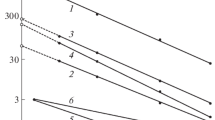Summary
This paper presents a model of the uplift by wind of heavy (i.e. saltating and unaffected by turbulent diffusion) soil particles. Detailed trajectories are not calculated, although trajectory heights are required and this necessitates taking account of the drag on particles. Quantities required as input are (a) the mass-concentration at a height equal to the roughness length above the surface for each size class, (b) the roughness length of the undisturbed surface, and (c) the friction velocity which is assumed to be controlled by the overlying wind and unaffected by erosion. The model is combined with a previously bublished model for lighter particles and applied to hypothetical size distributions for a range of friction velocities. Mean-diameter profiles and horizontal fluxes are obtained and found to agree well with observations by various workers.
Similar content being viewed by others
References
Sørensen, M.: An analytic model of wind-blown sand transport. Acta Mech. [Suppl.]1, 67–81 (1991).
Nalpanis, P., Hunt, J., Barrett, C.: Saltating particles over flat beds. J. Fluid Mech.251, 661–685 (1993).
Ungar, J., Haff, P.: Steady state saltation in air. Sedimentology34, 289–299 (1987).
Anderson, R., Hallet, B.: Sediment transport by wind: toward a general model. Geol. Soc. Am. Bull.97, 523–535 (1986).
Scott, W., Hopwood, J., Summers, K.: A mathematical model of suspension with saltation. Acta Mech.108, 1–22 (1995).
Raupach, M.: Saltation layers, vegetation canopies and roughness lengths. Acta Mech. [Suppl.]1, 83–96 (1991).
Jensen, J., Sørensen, M.: Estimation of some aeolian saltation transport parameters: a reanalysis of Williams' data. Sedimentology28, 547–558 (1986).
Greeley, R., Williams, S., Marshall, J.: Velocities of windblown particles in saltation: preliminary laboratory and field measurements. In: Eolian sediments and processes (Brookfield, M., Ahlbrandt, T., eds.), pp. 133–148. Amsterdam: Elsevier 1983.
Gerety, K., Slingerland, R.: Nature of the saltating population in wind tunnel experiments with heterogeneous size-density sands. In: Eolian sediments and processes (Brookfield, M., Ahlbrandt, T., eds.), pp. 115–131. Amsterdam: Elsevier 1983.
Hopwood, J., Scott, W.: The sizing of particles in terms of terminal velocity: a note on the interpretation of data of Gerety and Slingerland with particles sized in terms of terminal velocity. Catena17, 327–332 (1990).
Rasmussen, K., Mikkelsen, H.: Wind tunnel observations of aeolian transport rates. Acta Mech. [Suppl.]1, 135–144 (1991).
Leys, J.: The threshold friction velocities and soil flux rates of selected soils in south-west. New South Wales, Australia. Acta Mech. [Suppl.]2, 103–112 (1991).
Williams, G.: Some aspects of the eolian saltation load. Sedimentology3, 257–287 (1964).
White, B., Schulz, J.: Magnus effect in saltation. J. Fluid Mech.81, 497–512 (1977).
Author information
Authors and Affiliations
Rights and permissions
About this article
Cite this article
Hopwood, J.M., Scott, W.D. A mathematical model of saltation. Acta Mechanica 124, 199–211 (1997). https://doi.org/10.1007/BF01213025
Received:
Issue Date:
DOI: https://doi.org/10.1007/BF01213025




